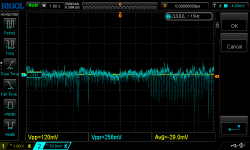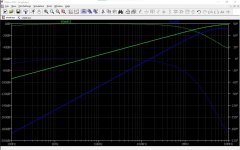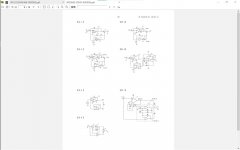Maybe it would help you to read up on what actually could cause oscillations. It's certainly not just the opamp GBP. Google 'phase shift'.If video OPAMP with 200 MHz doesn't oscillate on a breadboard, but some TI IC with GBW barely passing 20 MHz on the same board does oscillate - than internal circuits design of this audio IC was done by idiots.
Jan
1. It's you who brought TI product discussion to this thread.I use NJM too - the NJM2068 is a great basic opamp and it works fine for most audio uses. I just like the TI OPA1656 when I need lots of current drive and a FET input. When implemented well, they work without oscillation. Many people here in this forum seem to not have issues with TI products oscillating so perhaps there is an issue with your setup or circuit. We are not all TI “Fanboys” but venting your frustration with ad hominem attacks on the manufacturing design team is not very productive and isn’t making you any friends around here.
2. Osillation is not the initial subject as well.
Stop de-rail a thread, you are in my Ignore list, ebala.
The new high GBWP opamps good decoupling and layout and are far less forgiving of bad layout. For example, if you picked up just 100 nV of LF noise between the junction of the feedback resistors and the inverting input on an LM4562 operating at a closed loop gain of 20 dB, you could expect 10 mV noise at the opamp output, while on a 5534, the same figure is 100uV. Hence, testing these kinds of modern devices on an Amazon 830 will give erroneous results.Maybe it would help you to read up on what actually could cause oscillations. It's certainly not just the opamp GBP. Google 'phase shift'.
Jan
I don't understand what you say, nor I want to. See how LM4562 looks on a scope screen.The new high GBWP opamps good decoupling and layout and are far less forgiving of bad layout. For example, if you picked up just 100 nV of LF noise between the junction of the feedback resistors and the inverting input on an LM4562 operating at a closed loop gain of 20 dB, you could expect 10 mV noise at the opamp output, while on a 5534, the same figure is 100uV. Hence, testing these kinds of modern devices on an Amazon 830 will give erroneous results.
a). I'm happy with my 830 board;
b). My setup is the simplest way to differentiate an IC for undocumented feature
c). I do know what the issue, but it's illegal topic and already deleted by moderator.
I 'm asking again, plz, I don't need any advise.
My test results with NJM2122 shows, that IC outperforms OPA227 & OPA2202 !
And it's even competitive with AZ MCP6V97/87 , MAX44251 on low frequency end 0.1-10 Hz
Attachments
Instead of continuing with these invalid generalizations you should just state what you actually found out which is that NJM2122 seems to work better with your test circuit on a 830 protoboard.My test results with NJM2122 shows, that IC outperforms OPA227 & OPA2202 !
And it's even competitive with AZ MCP6V97/87 , MAX44251 on low frequency end 0.1-10 Hz
The damn metal to metal contacts of those protoboards produce more low frequency noise (sub 10 Hz) than most op amps, let alone “good” ones. Drift (which is very low frequency noise) measurements can’t be trusted.
And just because something doesnt outright oscillate in a poor grounding/decoupling environment doesnt mean that it’s achieving the best performance that it can. You leave capability on the table.
And just because something doesnt outright oscillate in a poor grounding/decoupling environment doesnt mean that it’s achieving the best performance that it can. You leave capability on the table.
No need to read more of this sore derailments😱You have no analytics skills. Logic behind my desision is dumb simple. If video OPAMP with 200 MHz doesn't oscillate on a breadboard, but some TI IC with GBW barely passing 20 MHz on the same board does oscillate - than internal circuits design of this audio IC was done by idiots.
I don't care if such IC would works on properly designed board with 4 layers and heavily decoupled, I would not tolerate that manufacturer would dictate me conditions what I should follow with my hobby grade project. There is always alternative, stop to be "obsessed" by TI.
9.|-- 172.69.156.2 0.0% 10 63.4 63.8 60.3 75.0 4.6
10.|-- 172.64.80.1 0.0% 10 66.8 66.5 60.6 89.5 9.7
Domain diyaudio.com
Domain Label diyaudio
IP Address
209.59.178.49
Nolite mittere margaritas ante porcos.
10.|-- 172.64.80.1 0.0% 10 66.8 66.5 60.6 89.5 9.7
Domain diyaudio.com
Domain Label diyaudio
IP Address
209.59.178.49
Nolite mittere margaritas ante porcos.
Sorry, just found out about the opa1656. I plan to use it on a RIAA preamp. The datasheet even recommends it for that.
But about high quality audio, compared to other very fine designs from Walt Jung, or even discrete preamps.
The one I intended to use was the LT1792, which I don't think is CMOS as the 1656 seems to be.
But about high quality audio, compared to other very fine designs from Walt Jung, or even discrete preamps.
The one I intended to use was the LT1792, which I don't think is CMOS as the 1656 seems to be.
Where are the pearls and who are the pigs?Nolite mittere margaritas ante porcos.
The one I intended to use was the LT1792, which I don't think is CMOS as the 1656 seems to be.
Right, its JFET and as such does quite a lot better at LF noise than the OPA1656.
Unfortunately, NJM2122 is planned to be discontinued.
They are good opamp for some applications such as microphone amplifier, but a unique example, Accuphase uses them in the line level error feed-forward circuit ANCC.
It senses inverting input of the inverting amplifier where are 1/(1+Aβ) of the distortion, then amplify them to -1/β time and add the first inverting amplifier output resulting error correction.
They are good opamp for some applications such as microphone amplifier, but a unique example, Accuphase uses them in the line level error feed-forward circuit ANCC.
It senses inverting input of the inverting amplifier where are 1/(1+Aβ) of the distortion, then amplify them to -1/β time and add the first inverting amplifier output resulting error correction.
Attachments
How tightly are R1,R2,R3,R4 matched in the Accuphase circuit? How tightly are R5,R6,R7,R8 matched?
Well, maybe 1% tolerance resistor? The schematic is not actual circuit from their products as you see the error amplification amp is 2 of closed loop gain, which is not applicable with NJM2122.
I had replicated it from pictures of PCBs but yesterday I found it had been patented in Japan, then confirmed the circuit topology is correct.
I had replicated it from pictures of PCBs but yesterday I found it had been patented in Japan, then confirmed the circuit topology is correct.
Attachments
Then there is a possibility of ~7% error in the error correction, which is MUCH greater than the original distortion ("error") to be corrected.
- Home
- Amplifiers
- Solid State
- Low Noise OPAMP NJM2122 is a new shining star



